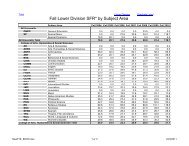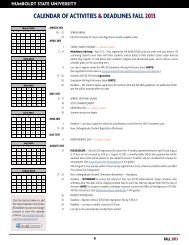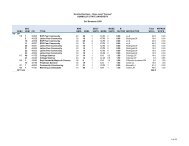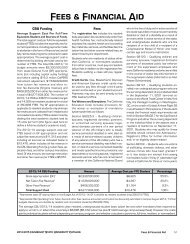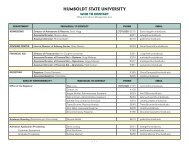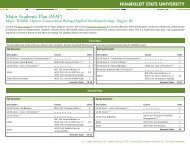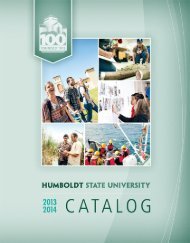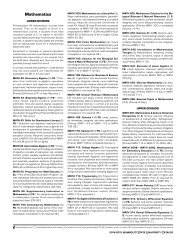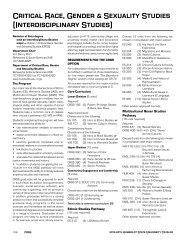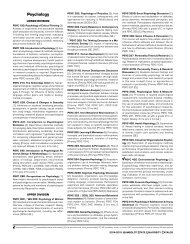2007-08 Academic Year - Humboldt State University
2007-08 Academic Year - Humboldt State University
2007-08 Academic Year - Humboldt State University
You also want an ePaper? Increase the reach of your titles
YUMPU automatically turns print PDFs into web optimized ePapers that Google loves.
MUS 150 / 450. <strong>Humboldt</strong> Symphony (2).<br />
Study/perform orchestral literature. Occasional<br />
off-campus concerts. [CR/NC. Prereq: IA based<br />
on auditions. Rep.]<br />
LOWER DIVISION<br />
MUS 103. Listening to the Movies (3). Movie<br />
classics will be viewed and discussed to acquire a<br />
comprehensive and practical understanding of the<br />
prevailing techniques employed in the art and craft<br />
of contemporary film scoring techniques. [GE.]<br />
MUS 104. Introduction to Music (3). Non-music<br />
majors learn styles, techniques, and forms of<br />
various musical periods. Lectures, recordings,<br />
concerts. Acquire greater understanding and<br />
enjoyment of music. [GE.]<br />
MUS 105. The American Musical (3). Historical<br />
survey of musical theatre in US, emphasizing<br />
Broadway productions. Song and dialog presented<br />
through recordings and videos. [GE.]<br />
MUS 110. Fundamentals of Music (4). For music<br />
majors needing additional preparation before<br />
entering MUS 214, for minors, and for general<br />
student wishing to improve knowledge/skills in<br />
beginning theory, keyboard, and aural comprehension.<br />
[Prereq: IA. Rep.]<br />
MUS 112. Piano I (1). Beginning class piano<br />
studies for music majors.<br />
MUS 113. Piano II (1). The second semester of<br />
class piano studies for music majors. [Prereq:<br />
MUS 112.]<br />
MUS 180. Special Topics Seminar (1-3). Topics<br />
relevant to performance practices, periods, or<br />
genre of music history and literature. [Rep.]<br />
MUS 214. Theory I (3). Diatonic melodic and<br />
harmonic practices involving analysis and 4-part<br />
writing. Properties of sound, scales, modes, triads,<br />
7th chords, figured bass, nonharmonic tones,<br />
chord progressions, cadences. [Prereq: MUS 110<br />
or passing score on placement test.]<br />
MUS 215. Theory II (3). Continues MUS 114.<br />
Secondary dominants, modulation, binary and ternary<br />
forms, diminished and nondominant chords.<br />
[Prereq: MUS 214 or IA.]<br />
MUS 216. Ear Training I (1). Comprehensive ear<br />
training correlated to MUS 214; develop music<br />
reading and perception skills through studies in<br />
rhythm, sight singing, dictation, keyboard, and<br />
notation. [Coreq: MUS 214 or IA.]<br />
MUS 217. Ear Training II (1). Continues MUS<br />
216. [Coreq: MUS 215 or IA. Prereq: MUS 214,<br />
216.]<br />
MUS 251. Music History: Antiquity to 1750 (3).<br />
Analyze musical styles and composition technique<br />
in examples selected from medieval, Renaissance,<br />
and baroque music. For music majors and minors<br />
or by instructor approval. [Prereq: MUS 214.]<br />
MUS 252. Music History: 1750 to Present (3).<br />
Analyze musical style in selected examples of classical,<br />
romantic, and 20th century music. Written<br />
research projects. [Prereq: MUS 215, 251.]<br />
UPPER DIVISION<br />
MUS 301. Rock: An American Music (3). Major<br />
artists and movements of rock music studied in<br />
social, historical, and musical contexts. Pioneers<br />
of the 50s through today’s rebellion, experimentation,<br />
and new trends. [GE.]<br />
MUS 302. Music in World Culture (3). Musical<br />
traditions of Native American, African, and Asian<br />
cultures compared in artistic, social, religious, and<br />
political contexts. Distinctions between Western<br />
and non-Western music. [GE. DCG-n.]<br />
MUS 305. Jazz: An American Art Form (3).<br />
Uniquely American art form of jazz. African-<br />
American jazz innovators. Perspectives of history,<br />
society, performance, gender, and current trends.<br />
Lecture, listening, discussion. [GE.]<br />
MUS 312. Musicianship (2). Concepts/skills in<br />
music for use in self-contained classroom. Prereq:<br />
junior or senior or IA.]<br />
MUS 313. Musicianship (2). Continues MUS<br />
312. [Prereq: MUS 312.]<br />
MUS 314. Theory III (3). Neapolitan, augmented<br />
6th, and altered chords; chromatic harmony;<br />
basic 18th century polyphony; borrowed chords;<br />
9th, 11th, and 13th chords; variation techniques;<br />
modulation; sonata form. [Prereq: MUS 215 or<br />
IA.]<br />
MUS 315. Theory IV (3). 20th century techniques:<br />
tone rows, set theory, quartal harmony,<br />
polytonality, pandiatonicism, chance operations,<br />
modal writing, polymeters, and asymmetric meters.<br />
[Prereq: MUS 314 or IA.]<br />
MUS 316. Ear Training III (1). Comprehensive<br />
ear training correlated to MUS 314. Develop<br />
music reading and perception skills through<br />
studies in rhythm (traditional, 20th century), sight<br />
singing (traditional, 20th century), dictation, and<br />
keyboard. [Coreq: MUS 314. Prereq: MUS 215<br />
and 217 or IA.]<br />
MUS 317. Ear Training IV (1). Continues MUS<br />
316. Coreq: MUS 315. [Prereq: MUS 314 (C)<br />
and 316 (C) or IA.]<br />
MUS 318. Jazz Improvisation (2). Train in contemporary<br />
art of jazz improvisation through use<br />
of scales, chords, and idiomatic musical devices.<br />
[Prereq: MUS 214 or IA. Rep once.]<br />
MUS 319. Development of Musical Concepts<br />
(2). Survey music teaching process used in selfcontained<br />
classrooms. General music curriculum;<br />
material development; fieldwork; underlying<br />
aesthetic, philosophical, and psychological foundations<br />
of elementary school programs. [Prereq:<br />
MUS 314 or 313; admission to music credential<br />
track; IA.]<br />
MUS 320. Composition: Film Scoring (3). Study<br />
and compose music for scenes of dramatic and<br />
narrative films. [Rep.]<br />
MUS 320B. Composition: Jazz & Pop Arranging<br />
(3). Arranging techniques. Emphasis on big band.<br />
[Prereq: MUS 215. Rep.]<br />
MUS 320C. Composition: Electronic Music<br />
(3). Use computer-driven devices to compose<br />
electronic and electro-acoustic music. [Prereq:<br />
MUS 215. Rep.]<br />
MUS 324. Contemporary Composition Techniques<br />
(2). General survey of contemporary composition.<br />
Individual projects; concert presentation.<br />
[Coreq: MUS 215. Prereq: IA.]<br />
MUS 326. Counterpoint (2). Overview of Renaissance,<br />
common practice, and modern counterpoint.<br />
Emphasis: baroque techniques. [Prereq:<br />
MUS 315 or IA.]<br />
MUS 330. Piano IV (1). Piano accompaniments<br />
developed from chord symbols, notated melodies,<br />
or choral and instrumental music. Chord voicing,<br />
chord analysis, stylistic appropriateness. [Prereq:<br />
MUS 130. Coreq: MUS 314. IA. Rep.]<br />
MUS 334. Fundamentals of Conducting (2).<br />
Beat patterns, expressive gestures, score reading,<br />
musical ranges, rehearsal planning, correction<br />
of errors. [Prereq: MUS 315 (C), IA.]<br />
MUS 338 Vocal & Instrumental Scoring (3).<br />
Techniques of arranging music for vocal and instrumental<br />
performing groups (large and small).<br />
Score layout and legibility, part copying, transpositions,<br />
and ranges of instruments and voices.<br />
[Prereq: MUS 315.]<br />
MUS 353. Accompanying (1). Keyboard accompanying<br />
for instrumental or vocal solos or groups.<br />
[Prereq: MUS 220 (C). Rep.]<br />
MUS 356. Lyric Diction (2). Techniques and<br />
problems of singers’ pronunciation in all major<br />
languages. [Prereq: MUS 215 or IA.]<br />
MUS 360. Music Technology (2). Computer technology<br />
and music applications. Keyboard controllers<br />
and music printing programs. [Prereq: IA.]<br />
MUS 361. Music Technology: Recording &<br />
Playback (2). Digital and analog recording techniques<br />
combined with digital sequencing, CD-ROM<br />
burning, use of digital synthesizers, and soft<br />
synthesizer design.<br />
MUS 370S. String Techniques I (.5). Instruction<br />
in string instrumental techniques and pedagogy.<br />
[Rep once.]<br />
MUS 370W. Woodwind Techniques I (.5).<br />
Instruction in woodwind instrumental techniques<br />
and pedagogy. [Rep once.]<br />
MUS 371S. String Techniques II (.5). Instruction<br />
in string instrumental techniques and pedagogy.<br />
[Prereq: MUS 370S. Rep once.]<br />
MUS 371W. Woodwind Techniques II (.5).<br />
Instruction in woodwind instrumental techniques<br />
and pedagogy. [Prereq: MUS 370W. Rep once.]<br />
MUS 372B. Brass Techniques I (.5). Instruction<br />
in brass instrumental techniques and pedagogy.<br />
[Rep once.]<br />
MUS 372P. Percussion Techniques I (.5). Instruction<br />
in percussion instrumental techniques and<br />
pedagogy. [Rep once.]<br />
MUS 373B. Brass Techniques II (.5). Instruction<br />
in brass instrumental techniques and pedagogy.<br />
[Prereq: MUS 372B. Rep once.]<br />
activ activity; (C) may be concurrent; CAN California articulation number; coreq corequisite(s); CR/NC mandatory credit/no credit; CWT communication & ways of thinking; DA dept approval<br />
228 Music<br />
<strong>2007</strong>-20<strong>08</strong> <strong>Humboldt</strong> <strong>State</strong> <strong>University</strong> Catalog



